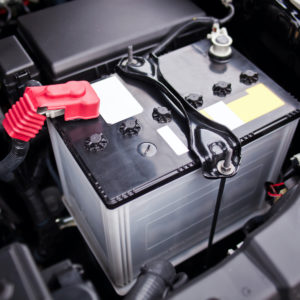There are times you must leave your car or truck behind for an extended period, but you can’t just park your vehicle in the driveway or garage and forget about it. Cars are meant for movement, and their parts will essentially atrophy without regular use. Instead, you must prepare your vehicle for long-term storage. The amount of time you plan to leave it will determine what needs to be done. A few weeks isn’t a big deal, a few months is.
What Do You Need For Long-Term Storage of Your Car?
Here are some of the most useful items and equipment that you’ll need when you put your vehicle in long-term storage:
Battery Tender
One of the biggest concerns for long-term vehicle storage is the car battery. Parts like the alarm system, clock, and radio constantly draw power from the battery in what’s called parasitic draw. Usually, the alternator charges the battery while you’re driving. But if you store your vehicle for a long time, the battery won’t get the charge it needs to replenish what it lost to parasitic draw. It will eventually discharge.
Fortunately, you can prevent a discharge with a battery tender. Also called a trickle charger, the tender charges the battery like the alternator does when the engine’s running. It connects the car battery to a wall outlet, supplying the battery with enough power to prevent a discharge while also preventing overcharging.
For best results, remove your car battery from your vehicle. Move it to a dry surface made of nonconducting material. (Wood is a good choice, but avoid concrete.) Now you can connect the battery tender. Use a tender with an automatic shut-off function to prevent overcharging.
Our Top Picks For Battery Tenders
- Battery Tender 022-0165-DL-WH Battery Charger
- Battery Tender 022-0150-DL-WH Battery Charger
- Battery Tender® 021-0123 Battery Charger

Car Cover
You’ll need a secure parking place for your car or truck for long-term storage. Usually, you can park it in your garage. If you don’t own a covered space, you should look for an indoor long-term parking facility that fits your budget. Parking your vehicle outdoors is a last resort, although you can take steps to reduce the problems with outdoor parking.
Wherever you plan to park your vehicle, you should put a car cover on it. The cover protects your vehicle from various external factors. Do not park under a tree or trees, since they drop leaves and limbs. A whole tree may fall on the car in a windstorm and result in expensive repairs.
A car cover is particularly indispensable if you intend to leave your vehicle parked outdoors. Make sure to get a weatherproof product intended for outdoor use. The outdoor car cover must be made from a breathable material that lets air pass while blocking dirt and precipitation.
Our Top Picks For Outdoor Car Covers
- Covercraft CB31AC 5-Layer All Climate Series Indoor And Outdoor Car Cover
- Covercraft CA64HG WeatherShield HD Series Indoor And Outdoor Car Cover
- Bestop 81044-01 All-weather Series Indoor And Outdoor Car Cover
Even if your vehicle will stay in an indoor parking space, you should still put a car cover on it before leaving it for long-term storage. The car cover prevents dirt and dust from directly gathering on the surface of your vehicle’s body panels.
Furthermore, the car cover protects against rust. Some garages might have leaks and other issues that raise humidity. A car cover prevents moisture from reaching exposed metal parts, reducing the risk of corrosion.
Our Top Picks For Indoor Car Covers
- Covercraft FFA63FC Form-Fit Series Indoor Car Cover
- Covercraft C18438PD Polycotton Series Indoor Car Cover
- Covercraft C44TF Flannel Series Indoor Car Cover
- Covercraft C16690IC 5-Layer Indoor Series Indoor Car Cover
Jack Stands
You’ve probably used jack stands to raise your vehicle from the ground to access its underside or replace its wheels and tires. But did you know that jack stands can help prevent flat spots from forming on the tires?
Flat spots are patches of tire tread that have become flat and rigid. They’re created by the vehicle’s weight putting pressure on the tire’s contact patch. Flat spots form faster in cold temperatures. Low-profile and performance tires are more likely to develop flat spots. Raising the vehicle off its suspension also helps keep the suspension crisp for extremely long term storage.
Sometimes, it’s possible to fix flat-spotting by driving your vehicle until its tires sufficiently warm up. Other flat spots won’t disappear, even after the tires reach typical operating temperatures. You must replace the entire tire because the flat spot cannot effectively grip the road surface.
Long-term storage increases the chance of flat-spotting. Your vehicle puts its weight on the contact patch for longer periods, making flat spots more likely to appear on the tires.
Fortunately, jack stands can minimize the risk. Put a jack stand under each corner of your vehicle and raise it. You can now remove the wheels and tires for proper storage. Since the tires aren’t in contact with the ground and don’t have to bear the vehicle’s weight, they’ll last longer and stay free of flat spots.
Our Top Picks For Jack Stands
Drain The Fuel Tank or Add Stabilizer
One thing that is often overlooked is the fuel that is in the tank. Rotten fuel can clog injectors, ruin the fuel pump, and coat the insides of the fuel lines with varnish. If you can’t completely drain the fuel (and this can be difficult), then add fuel stabilizer, which is good for 6 months to 2 years, depending on conditions. This is one of the most important parts of vehicle storage.
Rotten fuel can clog injectors, ruin the fuel pump, and coat the insides of the fuel lines with varnish. If you can’t completely drain the fuel (and this can be difficult), then add fuel stabilizer, which is good for 6 months to 2 years, depending on conditions. This is one of the most important parts of vehicle storage.
– Richard McCuistian, ASE Certified Master Automobile Technician
Our Top Picks For Fuel Stabilizer
Leather Care Products
Leather upholstery looks and feels great, but the material requires special care. You must regularly clean and condition leather to prevent it from drying out. Otherwise, it can crack or fade, especially when exposed to direct sunlight, hot temperatures, or shifting humidity.
Apply a long-lasting leather conditioner to your vehicle’s leather upholstery before putting it in long-term storage. When combined with other measures, such as a car cover or indoor parking to block direct sunlight, a high-quality leather conditioner can preserve the expensive upholstery.
Our Top Picks For Leather Care Products
- Chemical Guys SPI_401_16 Leather Conditioner (16 Fl. Oz.)
- Meguiars G201316 Leather Care
- Meguiars G10900 Leather Care Universal Leather Protectant
- Sonax Leather Conditioner Premium Class Leather Care Cream (250 ml Bottle)
Wheel Chocks
Usually, you should engage the parking brake once you’ve maneuvered your vehicle into the parking lot. That safety habit becomes a liability, though, if you’re going to put your car or truck into at least a month of storage. If you leave the brakes engaged, the brake pads and brake rotors might fuse, leading to problems later.
Instead, use wheel chocks to keep your vehicle immobile in long-term storage. You might know these wedge-shaped equipment as tire stoppers. Wedge the wheel chocks under the tires to prevent rotation that will move your car and truck. Make sure to disengage the parking brake before leaving your vehicle.
Between jack stands and wheel chocks, what’s better for your vehicle’s tires during long-term storage? If you’re going to store your vehicle for less than a month and it uses regular tires, you can safely use wheel chocks. However, if you plan to leave your car or truck for several months and use low-profile or performance tires, raise it on jack stands and take the tires or wheels off.
Our Top Picks For Wheel Chocks
When done properly, long-term storage will keep your vehicle in good condition. Using these tools and equipment will help ensure you can drive your car or truck without a hitch when you return.
Any information provided on this Website is for informational purposes only and is not intended to replace consultation with a professional mechanic. The accuracy and timeliness of the information may change from the time of publication.





















